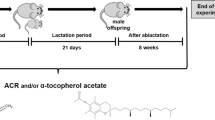Abstract
Acrylamide and its three neurotoxic analogues, which are known to induce testicular damage in animals, were tested for reproductive toxicity in male and female mice and for the effect on germ cells in males, after subchronic treatment. After mating the treated males with untreated females, a decrease in fertility rate for all analogues except for N-hydroxymethylacrylamide, and an increase in the number of resorptions/dam for all test compounds were found. When untreated males were mated with treated females, an increase in the number of resorptions/dam was seen only after acrylamide dosing without any effect on the fertility rate. The reproductive toxicity appeared with only slight or no testicular atrophy, and without any apparent neurotoxicity after treatment with all test compounds. High doses of all test compounds produced both a decreased sperm count and an increase in abnormal sperm morphology.
Similar content being viewed by others
References
Dixon RL (1985) Aspects of male reproductive toxicology. In: Hemminki K, Sorsa M, Vainio H (eds) Occupational hazards and reproduction. Hemisphere Publ Corp, Washington, New York, London
Duncan RC, Knapp RG, Clinton Miller III M (1983) Experimental design and analysis of variance. In: Introductory Biostatistics for the Health Sciences, 2nd edn. John Wiley & Sons, New York, Chichester, Brisbane, Toronto, Singapore, p 137
Hashimoto K, Sakamoto J, Tanii H (1978) Gonadotropic effects of acrylamide and N-hydroxymethylacrylamide in animals. Proc Medichem Conf 19: 278–289
Hashimoto K, Sakamoto J, Tanii H (1981) Neurotoxicity of acrylamide and related compounds and their effects on male gonads in mice. Arch Toxicol 47: 179–189
Hashimoto K, Tsuji H, Tanii H (1984) Distribution and binding studies of acrylamide. Neurotoxicology 5: 306–307
IPCS (1985) Effects on animals. In: Aldridge et al (eds) Environmental health criteria 49. Acrylamide. WHO, Geneva, p 43
McCollister DD, Oyen F, Rowe VK (1964) Toxicology of acrylamide. Toxicol Appl Pharmacol 6: 172–181
Tanii H, Hashimoto K (1984) Inhibition of brain enolases by acrylamide and its related compounds in vitro, and the structure-activity relationship. Experientia 40: 971–972
Wyrobek AJ, Bruce WR (1975) Chemical induction of sperm abnormalities in mice. Proc Natl Acad Sci 72: 4425–4429
Author information
Authors and Affiliations
Rights and permissions
About this article
Cite this article
Sakamoto, J., Hashimoto, K. Reproductive toxicity of acrylamide and related compounds in mice — effects on fertility and sperm morphology. Arch Toxicol 59, 201–205 (1986). https://doi.org/10.1007/BF00290538
Received:
Issue Date:
DOI: https://doi.org/10.1007/BF00290538




